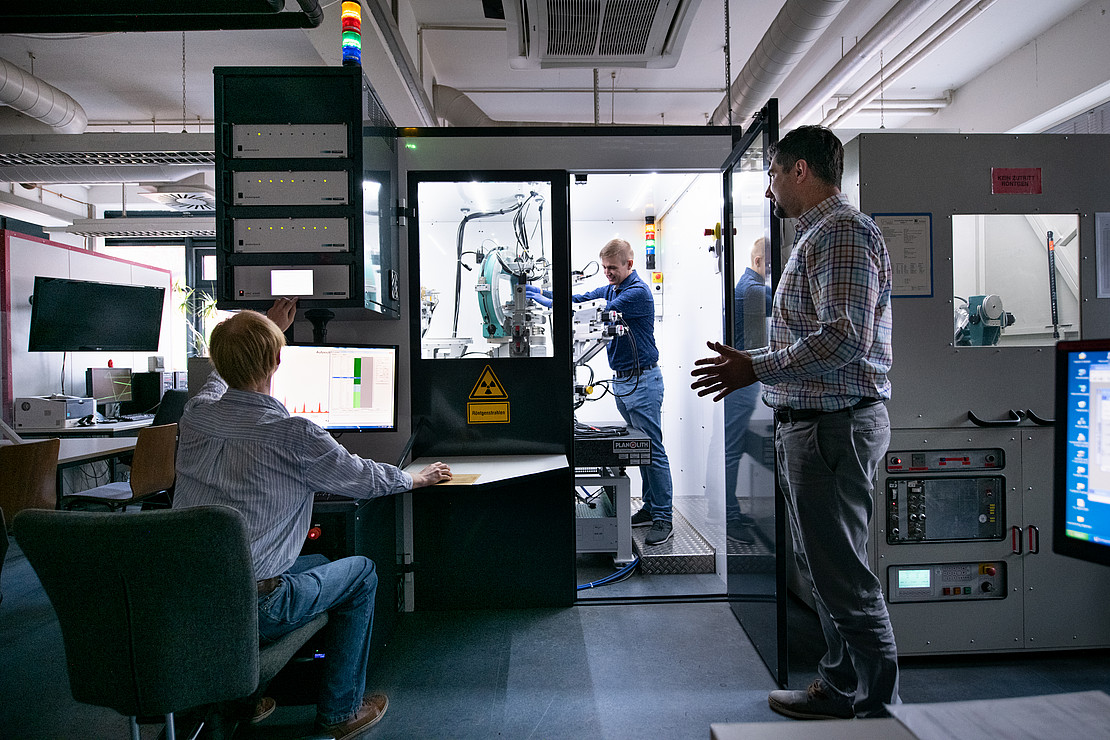Meldung
AI supports analysis of metallic materials
 Image: Paavo Blafield.
Image: Paavo Blafield.The inner structure of individual crystalline areas, known as "grains", is decisive for the properties of metallic materials. Their arrangement has a significant influence on the strength and the behavior of the metals when deformed. So-called shape memory alloys, for example, change their shape due to temperature-related changes in the internal crystal structure. "Creating a suitable microstructure in these special materials is a major technical challenge. Checking this in detail using X-ray analysis is particularly complex," explains Prof. Thomas Niendorf, Head of the Department of Metallic Materials.
Researchers often use X-ray diffraction methods for this purpose. This involves directing a focused X-ray beam at the material samples. The beam is deflected at its crystal lattice - in physical terms, diffracted. A detector receives the diffracted X-rays and software displays their intensity in a so-called pole figure. They rotate and tilt the material sample until a pole figure is created from the measurement data. These series of measurements often last for several days. Using the pole figures, the researchers can calculate the arrangement and orientation of the crystals in the metal.
"With our specially developed algorithm, we are three times faster," reports David Meier, information scientist from the Helmholtz-Zentrum Berlin and the Department of Intelligent Embedded Systems at the University of Kassel (Head: Prof. Bernhard Sick). "Using machine learning, it is trained to create a complete reconstruction of the pole figure from just a small section of the real measurement data of a few hours. It differs only minimally from the original." To do this, Meier worked with the materials engineers to create pole figures of random arrangements of grains in the metal using a simulation. Using these simulated images, a customized deep learning architecture learns to generate the complete pole figure from a section. This "reconstruction network" can reconstruct the remaining areas of a small section of a real measured pole figure. The subsequent comparison of the reconstruction and the real, complete measurement results of the sample shows: The reconstruction network can analyze the sample with sufficient accuracy for the applied example. However, in order to statistically prove that the developed method works in other real-life scenarios, it must be evaluated in follow-up studies with other samples made of different materials, says David Meier.
The researchers in the Department of Metallic Materials are enthusiastic about the collaboration with computer science: "We only need a few hours to analyze the micro-crystal structure and can even reliably reconstruct areas that we would not have been able to reach technically with our experimental setup," says Dr. Alexander Liehr, head of the X-ray fine structure analysis working group. The combination of modern measurement technology and artificial intelligence could also support the research and development of high-performance and durable materials in the future.
Publication:
Meier, D., Ragunathan, R., Degener, S., Liehr, A., Vollmer, M., Niendorf, T., Sick, B.: Reconstruction of incomplete X-ray diffraction pole figures of oligocrystalline materials using deep learning Scientific Reports. 13, 5410 (2023). https://doi.org/10.1038/s41598-023-31580-1
Contact:
David Meier
Department of Intelligent Embedded Systems
Phone: +49 561 804-6048
Email: meier.david[at]uni-kassel[dot]de
Press contact:
Sebastian Mense
University of Kassel
Communication, Press and Public Relations
Phone: +49 561 804-1961
E-mail: presse[at]uni-kassel[dot]de